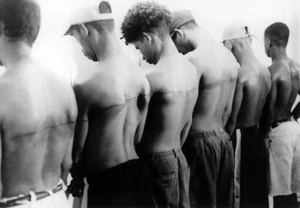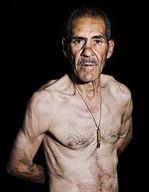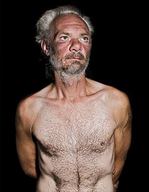Santiago Sierra failed make a dent on the politics of economic power when he paid a pittance to unemployed young men to allow tattooed line to be permanently inscribed across their backs, like a scar from the lash of a whip.
 From ARTnews:
From ARTnews:
Often working with refugee organizations, Sierra created pieces that involved workers from the local underclass being paid to do meaningless tasks: support a piece of Sheetrock at a 65-degree angle for an entire day; sit inside a cardboard box; or push around two-ton blocks of concrete. By designing such deliberately pointless “jobs,” he highlighted the disjunction between such workers and their work, showing labor as an imposed condition rather than a choice one makes. “The remunerated worker doesn’t care if you tell him to clean the room or make it dirtier,” Sierra remarks. “As long as you pay him, it’s exactly the same. The relationship to work is based only upon money.”
Degrading work is based only on money. By offering only degrading work, Sierra epitomized the problem. His reputation soared, but it’s doubtful his collaborators look back on their participation with pride.
What is exploitation? In the 1980s, many critics claimed that to photograph the homeless at all is to exploit them. Saner voices now prevail, but it’s hard in such work to avoid the didactic or sentimental.
Jesse Burke scores a poignant success in Low at Platform Gallery. Burke paid a group of homeless men to come to his studio, take off their shirts and be photographed. (Click to enlarge.)

 In the early 1980s, visiting a friend who’d moved to the lower East Side prior to its upgrade, I noticed watery blood stains in snow drifts. I asked if they documented fights from the previous night. No, said my friend. They mark places that the homeless relieve themselves.
In the early 1980s, visiting a friend who’d moved to the lower East Side prior to its upgrade, I noticed watery blood stains in snow drifts. I asked if they documented fights from the previous night. No, said my friend. They mark places that the homeless relieve themselves.
I thought of that exchange when looking at Burke’s photos. The men in them aren’t pathetic or heart-warming or instructive. They do not go forth and teach all nations. Instead, they are simply and clearly a genuine measure of themselves. To June 20.



Nice piece. I think you should enlarge upon those critics in the 1980s who wrote that the homeless should not be photographed at all.
The whip lash is right. I’d never thought of it that way, but it’s perfect.
Regina, that’s lovely writing and some wonderful comparisons and comments to make. The Burke show is terrific and the comparison to Santiago appropriate.
They also reminded me of Andres Serrano’s photographs of the homeless in NY in the mid-1990s. They are some of the least sensational of all of his work but they were initially shown alongside his portrait photos of the Ku Klux Klan. Both groups were shown clothed (or cloaked) in his studio portraits. While he had tremendous sympathy for the homeless he also found he had surprising sympathy for the individual Klanspeople. He felt they were the lowest of the low and simply looking for someone to be lower than themselves. It’s surprising how good portraiture can still inspire such convincing feelings.